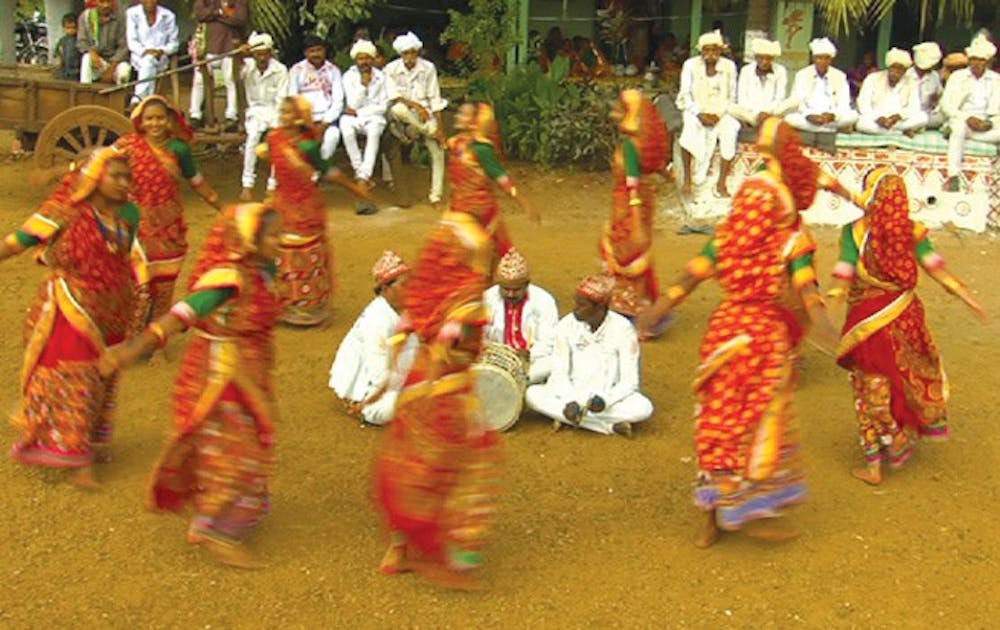In recent months, Duke Dance Professor Purnima Shah’s debut documentary has been making the film festival circuit. Dancing with the Goddess: the Ras-Garba Traditions of Gujarat, India was screened at the World Music and Independent Film Festival in Washington, DC and nominated for Best Documentary Music/Feature and Best Director at the same festival.
Dancing with the Goddess showcases the religious traditional dances of Garba, a circle dance that represents infinity or the circle of life. The Hindu dance is usually performed during Navratri, a nine-night festival in mid-October dedicated to the goddess Shakti, the personification of primoridal energy. Garba is often performed by women during religious worship, weddings and pregnancy, but it is also performed by male warriors to give thanks to Shakti and receive the goddess’ blessing. The dance brings entire villages together in celebration, a ritual that the film’s editor, James Haverkamp, adjunct instructor in the Program in Arts of the Moving Image, found fascinating.
“The kind of thing where the whole village comes together to celebrate together was very exotic to me,” Haverkamp said. “In the U.S. you don’t really find that.” Shah, who is associate professor of the practice of dance, was inspired to make this documentary after researching the songs and poetry usually accompanying the Garba dances.
“This was really rich poetry often describing their own relationships with the goddess,” Shah said. “It highlighted social and historical events, [generally] speaking of the ills of the times.”
Intrigued by her findings, Shah spent time traveling and speaking with the elders of small villages. She was shocked to find that the poetry of these songs and dances was slowly being lost with time. The elders explained that Shah had arrived too late, explaining that there are few women who still know these songs. Shah attributes the waning interest in traditional dances of worship to the commercial media, modernization and globalization in India.
Upon her return to Duke, Shah decided to document these dances and the religious tradition, hoping to archive as much of it as possible. Rather than recording the dances on her own, Shah applied for a Collaborative Arts Grant to facilitate her documentation. This transformed the project from footage that would have been used only as source material into a formal documentary. Haverkamp was especially impressed with the raw footage that Shah brought back from India.
“Professor Shah took on something really new [through] this project,” said Haverkamp. “This was the first time she’d made a movie.”
The most striking aspect of the documentary is the contrast drawn between traditional Garba and the new phenomenon of Disco-Garba. While traditional Garba focuses on the music, poetry and simple dance moves, Disco-Garba uses secularized lyrics and strobe lights to complement newer, more intricate choreography. Shah emphasized that her documentary isn’t meant to pass judgment or draw conclusions for the viewers but attempts to convey that Disco-Garba lacks much of the beauty of traditional Garba.
“[Disco-Garba] is a natural progression because the youth is so engrossed in these global forms of popular music, but as a performer and as a scholar [I feel] the tradition… and the emphasis on the poetry and literature is being compromised,” she said. “The aesthetic of the music composition is no longer there.”
Entertainment, rather than worship of the goddess Shakti, is at the center of Disco-Garba; the dancers are no longer focused on manifesting the primordial energy. Observing this firsthand, she experienced an urgency to record whatever traditional Garba remained for fear that in a decade it may be gone entirely.
Audience reactions to the film have been overwhelmingly enthusiastic. In addition to the telling award nominations, Dancing with the Goddess has received resounding positive reactions from many viewers. Shah said she was surprised by the audiences’ reactions.
“This was simply ethnographic research that emerged into a documentary through the grant. It is inspiring and motivating to make more films,” Shah said. What began as poetry research and a means to preserve an art form has transformed into a film recognized by international organizations, bringing Garba to the cultural forefront for many viewers.
Dancing with the Goddess will be shown September 26 in the John Hope Franklin Center from 12-1 p.m. as part of the “Wednesdays at the Center” series.
Get The Chronicle straight to your inbox
Signup for our weekly newsletter. Cancel at any time.

